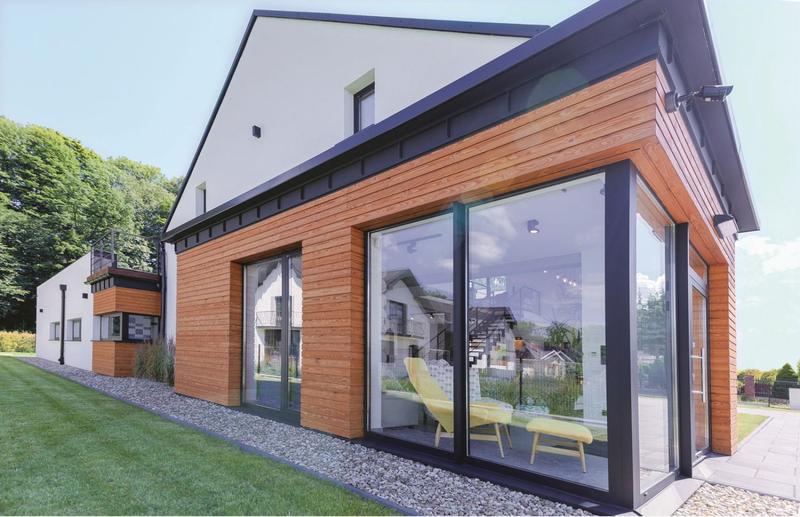CCTV monitoring cameras in a ready-made house - operating principle, costs
Expert's answer: Cameras, i.e. professional video surveillance (CCTV surveillance systems), are to deter potential criminals: burglars, thieves, vandals. However, they will not replace mechanical security (e.g. anti-burglary woodwork) or an alarm system in which they can be included. Robust doors and windows make it difficult for a criminal to enter the house, an alarm is supposed to discourage him, and if he fails, it informs the owner about a break-in or his attempt, while cameras deter and allow you to see what is happening around the building in real time and basically from anywhere in the world (as long as there is Internet or mobile network coverage).
The recordings made by them can be used by the police to identify criminals. However, you need to know that for facial recognition you need a high-quality image, and this is sometimes clearly worse than expected, e.g. as a result of data transmission disruptions or recording in bad weather and lighting conditions. In order to be able to see the face of an intruder in a cap with a visor or a hood pulled over his head, the camera cannot be mounted too high.
External cameras: dome (left: Krispol) and horn cameras, monitoring the permanent area (right: Wiśniowski).What does a video surveillance system (CCTV) consist of?
In general, the video monitoring system consists of cameras (at least one), data transmission infrastructure and recorder / recorders. We can view the image both on a monitor specially designed for this purpose, on a TV set, and - in the case of IP cameras - in a cell phone or on a laptop. The recording can be archived and / or sent e.g. to a monitoring center.

The cameras usually observe the surroundings of the house (driveway to the garage, entrance door, terrace, fence), less often its interior. Those installed outside must be resistant to weather conditions, some are equipped with vandal-proof housings. It is worth checking their IP protection class, which informs about how solidly the device is protected against water and dust. For example, IP 54 means that protection against dust and rain (splashing water from any direction) is ensured.
The cameras can work in continuous mode or turn on after receiving a signal from the motion detector. If the image is to be recorded also at night (or in worse lighting conditions), you need to choose the equipment for work in the dark (day / night camera or with IR LED illumination).
In analog vision systems, each camera is connected to an image transmitter and recorder. Image transmission "via cable" is more reliable than wireless communication, such transmission is also more difficult to hack (intercept transmitted data) - contrary to appearances, it is a serious threat. Connecting the recorder (placed in a safe place) and cameras with cables, however, requires drilling many holes and leading tens of meters of cable. Which should be protected against unauthorized access.
In the case of connecting the recorder and cameras by wire, you can choose devices with PoE (Power over Ethernet), i.e. cameras powered by a classic twisted-pair cable, which is used for data transmission. Thanks to this, there is no need to run a separate power cable.
Full HD camera module for the VX Infinity outdoor detectorIn the so-called IP network monitoring, cameras wired or wireless communicate with the recorder or the Internet and are treated as elements of the home computer network. This is a good solution for a finished home, because there is no need to run cables between devices. These use either cellular telephony or WLAN - a local wireless communication network commonly used to access the Internet. IP cameras can be conveniently controlled, e.g. using a smartphone application, in which we can also view the image recorded by them. Of course, it can be archived - in a network video recorder (Network Video Recorder) on disks or SD cards, or in the so-called cloud.
We can view the image from the IP camera anywhere - all you need is a smartphone. (Photo by Fibaro) Even an extensive building monitoring system can be wirelessly supervised. (photo: Fibaro)What to consider when choosing a registrar?
When choosing a recorder, you take into account how many cameras will be recorded: 4, 8, 16? If we want to access recordings via the Internet, the device should have a LAN input. A simple monitoring set (4 cameras, digital recorder) costs several hundred to thousand zlotys. A camera transmitting the image via the Internet to any mobile device costs about PLN 200. Some install dummy cameras - with flashing LEDs or motion sensors, which change their position upon detection. This security is cheap, but it will only scare complete amateurs. Importantly, the equipment should not record what is happening, for example, on the neighbors' property. This is an illegal act that allows you to freely monitor only your own area!
Janusz Werner opening: Satel
Do you appreciate our advice? You can get the latest every Thursday!







